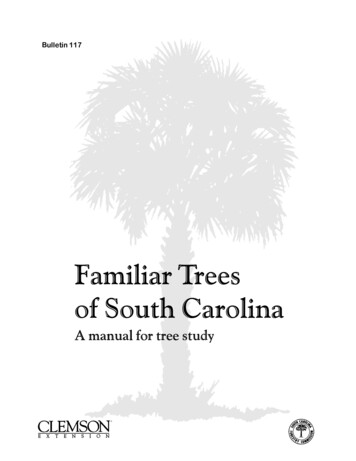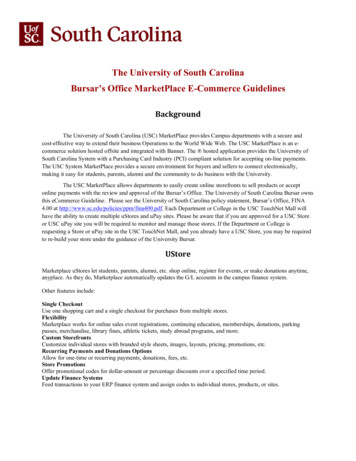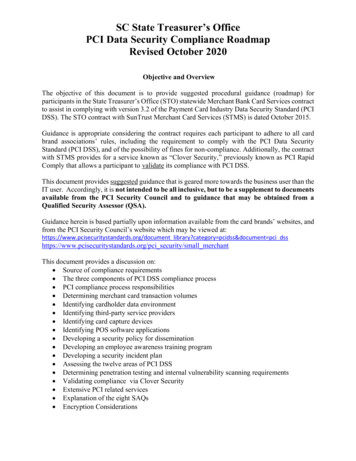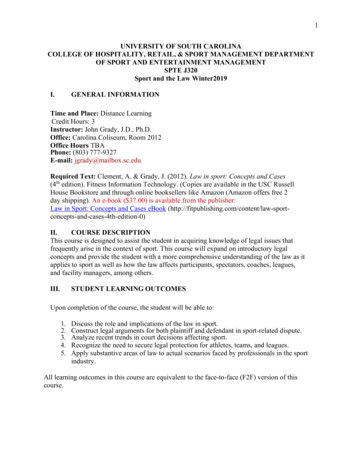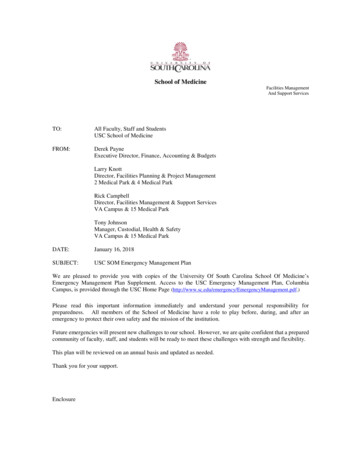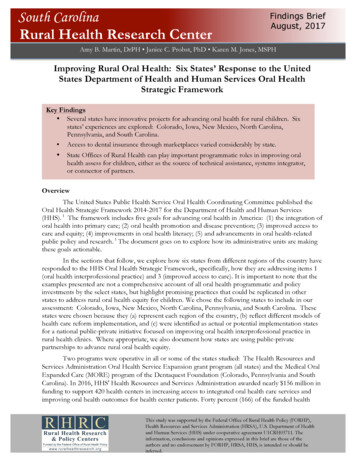
Transcription
South CarolinaRural Health Research CenterFindings BriefAugust, 2017Amy B. Martin, DrPH Janice C. Probst, PhD Karen M. Jones, MSPH.Improving Rural Oral Health: Six States’ Response to the UnitedStates Department of Health and Human Services Oral HealthStrategic FrameworkKey Findings Several states have innovative projects for advancing oral health for rural children. Sixstates’ experiences are explored: Colorado, Iowa, New Mexico, North Carolina,Pennsylvania, and South Carolina. Access to dental insurance through marketplaces varied considerably by state. State Offices of Rural Health can play important programmatic roles in improving oralhealth assess for children, either as the source of technical assistance, systems integrator,or connector of partners.OverviewThe United States Public Health Service Oral Health Coordinating Committee published theOral Health Strategic Framework 2014-2017 for the Department of Health and Human Services(HHS). 1 The framework includes five goals for advancing oral health in America: (1) the integration oforal health into primary care; (2) oral health promotion and disease prevention; (3) improved access tocare and equity; (4) improvements in oral health literacy; (5) and advancements in oral health-relatedpublic policy and research. 1 The document goes on to explore how its administrative units are makingthese goals actionable.In the sections that follow, we explore how six states from different regions of the country haveresponded to the HHS Oral Health Strategic Framework, specifically, how they are addressing items 1(oral health interprofessional practice) and 3 (improved access to care). It is important to note that theexamples presented are not a comprehensive account of all oral health programmatic and policyinvestments by the select states, but highlight promising practices that could be replicated in otherstates to address rural oral health equity for children. We chose the following states to include in ourassessment: Colorado, Iowa, New Mexico, North Carolina, Pennsylvania, and South Carolina. Thesestates were chosen because they (a) represent each region of the country, (b) reflect different models ofhealth care reform implementation, and (c) were identified as actual or potential implementation statesfor a national public-private initiative focused on improving oral health interprofessional practice inrural health clinics. Where appropriate, we also document how states are using public-privatepartnerships to advance rural oral health equity.Two programs were operative in all or some of the states studied: The Health Resources andServices Administration Oral Health Service Expansion grant program (all states) and the Medical OralExpanded Care (MORE) program of the Dentaquest Foundation (Colorado, Pennsylvania and SouthCarolina). In 2016, HHS' Health Resources and Services Administration awarded nearly 156 million infunding to support 420 health centers in increasing access to integrated oral health care services andimproving oral health outcomes for health center patients. Forty percent (166) of the funded healthThis study was supported by the Federal Office of Rural Health Policy (FORHP),Health Resources and Services Administration (HRSA), U.S. Department of Healthand Human Services (HHS) under cooperative agreement U1CRH03711. Theinformation, conclusions and opinions expressed in this brief are those of theauthors and no endorsement by FORHP, HRSA, HHS, is intended or should beinferred.
Findings BriefAugust, 2017centers are located in rural areas. These Oral Health Service Expansion (OHSE) supplemental fundsare intended to increase the number of patients receiving oral health services and the number of oralhealth service providers at health centers. These supplements are ongoing annual awards. The MORECare program seeks to expand the provision of primary and secondary oral health care in primary caremedical offices, with a focus on rural populations. The program is implemented through collaborativeefforts of State Office of Rural Health linked with rural primary care practices. Further information isavailable at improvementinitiatives/medical oral expanded care.The states studied reported promising practices for improving oral health in rural communitiesthrough a variety of approaches: expansion of oral health programs at Federally Qualified HealthCenters, marketplace dental plans, interprofessional practice pilot projects, and access to careimprovements. In all instances, the State Offices of Rural Health appear to play importantprogrammatic roles either as the source of technical assistance, systems integrator, or connector ofpartners. As individual states and federal agencies continue to follow the HHS Oral HealthFramework, it is essential to involve partners who understand the uniqueness of rural health systems aswell as oral health issues.2
ColoradoFindings BriefAugust, 2017Background: An estimated 23% of Colorado’s 2015 population of 5.5million persons are under age 18. Statewide, 70.1% of parents reported theirchild’s oral health as excellent or very good; 77.6% reported that their childhad received a preventive medical visit in the past year.2 As reported by theAmerican Dental Association, 53% of dentists in Colorado participated inMedicaid for child services in 2014, compared to 42% across the U.S.3Fifteen of Colorado’s 64 counties are geographic dental health professional shortage areas.IMPROVING ACCESS TO ORAL HEALTH CARESafety Net Capacity. Colorado had 20 Federally Qualified Health Centers (FQHCs) in 2015.Seventeen FQHCs provided dental services; they covered 30 counties. Sixteen of the 17 FQHC dentalprograms in 2015 provided a full scope of services, with the 17th FQHC using a dental hygienist toprovide screenings. Ten health Centers in Colorado received HRSA Oral Health Service Expansionawards or a total 2016 award amount of more than 3.7 million in oral health expansion funding for 10community health centers in 2016.Dental Insurance through the Marketplace. Colorado offers pediatric dental benefits throughmedical insurance plans, however participation rates are unavailable. Although stand-alone dental plansfor the other states included in this brief are reported at HealthCare.gov,4 Colorado is not included.According to a consumer website, www.coloradohealthinsurance.com,5 Colorado had nine insurancecompanies offering stand-alone plans.In addition to these dental insurance plans,the consumer website also promotes twodiscount plans, which are not insuranceproducts but plans that offer discounts forenrollees who are likely uninsured.ADVANCING ORAL HEALTHINTERPROFESSIONAL PRACTICEInsurance CompanyNumber ofPlansHumana One3Alpha Dental Plan2Delta Dental of Colorado1United Health One2National General1Innovations through Oral HealthAmeritas Dental Insurance3Interprofessional Practice. Cavity Free atThree is an initiative aimed at improving theCignaUnpublisheddelivery of oral health prevention by medicalAnthem Blue Cross Blue Shield3and dental providers through training and theDental Plans.comUnpublishedprovision of evidence-based resources andtools. A description of the project and itsresources are available at http://www.cavityfreeatthree.org/. It was originally administered by thestate’s Area Health Education Center program then was moved under the Colorado Public HealthAgency. The initiative has considerable support from state government. The Governor has gone onthe record stating his plan is to ensure children are covered and treated, recognizing the link betweenoral and physical health. Cavity Free at Three is supported through several key public-private partnerships. Financialsupport comes from Delta Dental of Colorado Foundation, Kaiser Permanente, Rose3
Colorado Findings BriefAugust, 2017Community Foundation, Caring for Colorado Foundation, and the Colorado HealthFoundation.Colorado is an implementation state for the DentaQuest Institute’s Medical Oral Expand(MORE) Care Initiative. This public-private partnership builds on State Office of Rural Healthleadership to facilitate adoption of oral health interprofessional practice in rural health clinics.This work includes defining optimally efficient collaborative referral management relationshipswith community dentists. South Carolina served as the Phase 1 state. Colorado andPennsylvania are Phase 2 implementation states with broader replication planned in partnershipwith other state offices of rural health.A recurring theme in key informant interviews was the leadership model for championing ruraloral health interprofessional care that has been essential for Colorado’s success. The Universityof Colorado has been an instrumental partner for Cavity Free at Three. Specifically, MarkDeutchman, MD was identified as a champion and Colorado faculty, particularly the Directorof its Rural Family Medicine Residency Program, are regarded nationally as the ‘creator ofintelligence’ around oral health interprofessional care. More information is available fit/.4
IowaFindings BriefAugust, 2017Background: An estimated 23% of Iowa’s 2015 population of 3.1 millionpersons are under age 18. Statewide, 72.2% of parents reported their child’soral health as excellent or very good; 82.1% reported that their child hadreceived a preventive medical visit in the past year.2 As reported by theAmerican Dental Association, 86% of dentists in Iowa participated inMedicaid for child services in 2014, compared to 42% across the U.S.3 Sixtysix (66) of Iowa’s 99 counties are geographic dental health professional shortage areas.IMPROVING ACCESS TO ORAL HEALTH CARESafety Net Capacity. Iowa has 14 Federally Qualified Health Centers (FQHCs) with 12 providing fulldental care. Iowa’s geography and population distribution is such that most FQHCs are located alongthe state’s border and serve residents of neighboring states. Approximately half the dental programsare located in small urban areas with others in more rural communities. In total, Iowa FQHCs providecare to 27 rural service areas, 9 in urban areas, and 4 from other states. Residents of Iowa’s borderstates are reported to seek dental care in Iowa due to better availability of dental providers. Five healthcenters in IA received HRSA Oral Health Service Expansion awards for a total 2016 award amount of 1.925 million.Strengthening the state’s safety net is also being accomplished through a public-private partnership withthe DentaQuest Foundation. In 2015, the Iowa Primary Care Association (PCA) was awarded a thirdand final year of funding through the DentaQuest Foundation’s Strengthening Oral Health Safety Net(SOHSN) initiative. This funding will allow the PCA to continue to support FQHC dental programs,encourage efforts to integrate care, work with other partners on oral health issues of regional andstatewide impact, and facilitate the provision of training and technical assistance to FQHC dentalprograms.Another example of a public-private partnership to strengthen Iowa’s dental safety net is its relationshipwith the Delta Dental of Iowa Foundation. The Iowa PCA partnered with Delta Dental of IowaFoundation to provide funds for two new dental directors to attend the National Oral Health LearningInstitute sponsored by the National Network for Oral Health Access (NNOHA). The learning instituteprovided new dental directors with the opportunity to increase the leadership skills necessary forrunning efficient dental clinics and to advocate for oral health in their communities.Dental Insurance through the Marketplace. In Iowa, there are medical insurance plans availablethrough its health insurance exchange that provide dental benefits for children (see table at top of nextpage), although enrollment estimates are not published. Iowans also have access to ten stand-alonedental insurance plans through four insurance companies in 2015 as summarized from HealthCare.gov.4All ten plans were available in each of Iowa’s 99 counties covering 12.1% of children in the state.6Rural-urban rates were not available.5
Findings BriefAugust, 2017IowaInsurance CompanyNumber of HighCoverage Plans*Number of LowCoverage Plans*BEST Life & Health Insurance Company22Delta Dental of Iowa21Dentegra Insurance Company01Truassure Insurance Company11*High coverage plans have higher premiums with lower copayments & deductibles. Low coverage plans havelower premiums with higher copayments & deductiblesDental Care Improvement Policies. Iowa is supporting evidence-based approaches to improveaccess through innovative billing practices. Dental Hygiene Reimbursement. The state has collaborative agreements with dental hygienistsworking in local public health settings who can bill Medicaid for care they provide, thus extendingthe dental workforce for underserved communities. Incentivized Risk Assessments. As a part of the state’s oral health plan, dentists receive a 10% increasein their fees if they use an approved risk assessment as a part of care delivery. Participatingdentists also receive a year-end bonus for their performance in risk-based care. This is financed bya Medicaid 1115 waiver. Program evaluation documents are available %5D 971.ADVANCING ORAL HEALTH INTERPROFESSIONAL PRACTICEOral Health Interprofessional Policies. Iowa is facilitating a practice environment that supports thepractice of oral health interprofessional practice in primary care and school-based settings to improvepediatric dental outcomes. Innovating Reimbursement Models: Like most states, Iowa authorizes fluoride varnish application byprimary care providers in its Medicaid program. The state has had discussions on separatingreimbursement of oral health preventive care from the Early, Periodic, Screening, Diagnosing,and Treating (EPSDT) encounter, which is currently bundled. As Iowa pursues privatization ofMedicaid, the likelihood of a separation was unclear at the time of interviews. Medicaid ManagedCare Organizations were already exploring how to collaborate with providers on oral health sincethey cannot pay dentists directly. Regional Accountable Care Organizations have begundeveloping in the state. Most have dental components. Screening Requirement. Iowa also has a statewide dental screening requirement for children enteringpublic schools, which is conducted by school nurses who have been appropriately trained by thestate health department. About 70 percent of all children provide dental screening certificates asrequired for entry into kindergarten or ninth grade ol-screenings).6
Findings BriefAugust, 2017New MexicoBackground: As of 2015, estimated 1.24 million children (age less than 18years) live in New Mexico. Nearly half (48%) of residents in New Mexicoconsider themselves Hispanic, while only 38% identify as white alone.Statewide, 62.6% of parents reported their child’s oral health as excellent orvery good; 81.1% reported that their child had received a preventive medicalvisit in the past year.2 As reported by the American Dental Association, 53%of dentists in New Mexico participated in Medicaid for child services in 2014, compared to 42% acrossthe U.S.3 Fifteen (15) of New Mexico’s 33 counties are geographic dental health professional shortageareas.IMPROVING ACCESS TO ORAL HEALTH CARESafety Net Capacity. New Mexico has 16 Federally Qualified Health Centers (FQHCs), all providingoral health services. In 2014, they employed 71 full-time and 95 part-time dentists, as well as 49 fulltime and 60 part-time dental hygienists. There are approximately 40 dental sites with 30 of them in ruralareas, many of which are co-located with other FQHC services. Approximately 90% of FQHCs have atleast one dental site. Four health centers in New Mexico received HRSA Oral Helth Service Expansioawards for a total 2016 award amount of 1.75 million. It was reported that these expansions wouldserve an additional 1,500 patients. While all health centers offer oral health services, only one-third ofpatients have access to oral health services at their clinical delivery site. Some access challenges werereportedly due to excessive dental provider vacancies in the FQHCs.One of the most significant challenges in expanding the dental safety net in New Mexico is thecompeting demand for behavioral health services. It was reported that state funding has beenhistorically difficult to leverage for expansion of safety net care because of fiscal constraints. The needand advocacy for behavioral health service expansion tends to overshadow oral health investments.Dental Insurance through the Marketplace. There are no health insurance plans in New Mexicothat provide dental benefits to pediatric enrollees. However, residents in all 33 counties had access to12 stand-alone dental insurance plans through three insurance companies in 2015 as summarized fromHealthCare.gov.4 The state had the third highest participation rate for stand-alone dental plans in thecountry, covering 22.0% of New Mexico’s children.6Insurance CompanyNumber of HighCoverage Plans*2Number of LowCoverage Plans* †2Blue Cross Blue Shield of New Mexico22Renaissance Life & Health Insurance Company22BEST Life & Health Insurance Company*High coverage plans have higher premiums with lower copayments & deductibles. Low coverage plans havelower premiums with higher copayments & deductibles.†An additional four urban counties had access to a low coverage plan administered by the Dentegra InsuranceCompany. These counties included: Bernalillo, Dona Ana, Santa Fe, and Valencia.Potential Dental Practice Act Modifications. In addition to strengthening the dental safety net anddental insurance products, New Mexico has explored the potential impact of dental therapy models onaccess to dental care for its residents. This work has been carried out through a public-privatepartnership that includes funding from HRSA and the W.K. Kellogg Foundation. The impact of dentaltherapists on improved access to dental care among rural has not been measured. The model in New7
New MexicoFindings BriefAugust, 2017Mexico was recently described in the Journal of Dental Hygiene, which indicated dental therapists aremostly employed in private practice settings and located in underserved communities.7ADVANCING ORAL HEALTH INTERPROFESSIONAL PRACTICENew Mexico is addressing innovations in oral health interprofessional practice through improvementsin higher education curriculum and care delivery models in underserved communities. Enhancements to Nurse Practitioner Training Program. The University of New Mexico’s School ofMedicine received funding from HRSA to enhance its oral health education program, includingthe integration of oral health evaluation skills for its Advance Nurse Practitioner Program.Specifically, they will use a primary care oral health delivery model that brings together dentists,physicians, and advance practice nurses to a community health center setting to address oralhealth disparities. Colocation and Training Model. The University of New Mexico, along with a coalition of publicprivate partnerships with funding from the W.K. Kellogg Foundation, developed a colocationmodel for oral health at a community health center in a rural setting. The model includedrobust training of primary care providers on what they can do within their scope of practices inthe state of New Mexico to address oral health.88
Findings BriefAugust, 2017North CarolinaBackground: As of 2015, estimated 2.26 million children (age less than 18 years)live in North Carolina. The majority (64%) of residents in North Carolinaconsider themselves white alone, with 9% identifying as Hispanic and 22%identifying as Black or African American. Statewide, 74.3% of parents reportedtheir child’s oral health as excellent or very good; 76.7% reported that their childhad received a preventive dental visit in the past year.2 As reported by theAmerican Dental Association, only 27% of dentists in North Carolina participated in Medicaid for childservices in 2014, compared to 42% across the U.S.3 Thirty-two (32) of North Carolina’s 100 countiesare geographic dental health professional shortage areas.IMPROVING ACCESS TO ORAL HEALTH CARESafety Net Capacity. As of January 2016, North Carolina had an estimated 36 public health dentalclinics with mobile services across 113 access points. The Department of Public Health provides directdental services through their public health dental clinics which employs teams of dentists, dentalhygienists and/or dental assistants. Fifteen (15) health centers in NC received HRSA Oral HealthService Expansion awards for a total 2016 award amount of 3.3 million.Shifts in Medicaid Participation. It is estimated that North Carolina Medicaid provides dentalcoverage for approximately 1.1 million children. The state observed a decline in enrollment in theChildren’s Health Insurance Program (CHIP) after the passage of the Affordable Care Act. Anestimated 70,000 children were moved from CHIP to Medicaid. Historical CHIP enrollment ran ashigh as 250,000 and is now around 100,000.Dental Insurance through the Marketplace. There are some medical insurance plans that providefor pediatric dental coverage, although market penetration estimates are unpublished. NorthCarolinians in all 100 counties had access to ten stand-alone dental insurance plans through threeinsurance companies in 2015 as summarized from HealthCare.gov.4 The state had the fourth lowestrate (3.6%) of children participating in stand-alone dental plans in the U.S.6Insurance Company (counties served)BEST Life & Health Insurance Company (n All100)Renaissance Life & Health Insurance Company(n All 100)Truassure Insurance Company (n not available)Number of HighCoverage Plans*2Number of LowCoverage Plans*22211*High coverage plans have higher premiums with lower copayments & deductibles. Low coverage plans havelower premiums with higher copayments & deductibles.An additional seven counties had access to a low coverage plan administered by Dentegra InsuranceCompany. Only one (Richmond County) of the seven counties was considered rural or underserved.Another 40 counties had access to a second low coverage plan administered by The Guardian LifeInsurance Company. Seven of the 40 were designated as rural or underserved: Anson, Bladen, Greene,Montgomery, Richmond, Sampson, and Warren. Richmond is the only rural or underserved county tohave access to all dental insurance plans. It is in close proximity to both Pinehurst and Fort Bragg,9
North CarolinaFindings BriefAugust, 2017which are significant tourist and military communities, respectively, which might explain the marketpenetration of dental plans.ADVANCING ORAL HEALTH INTERPROFESSIONAL PRACTICEInnovations in Oral Health Equity through Interprofessional Practice. North Carolina hasdemonstrated considerable leadership in the area of pediatric oral health interprofessional practice,particularly with application of fluoride varnish for children by primary care medical practices.9,10Significant leadership came through the state’s funding from the Children’s Health Insurance ProgramReauthorization Act (CHIPRA) of 2009. The state’s CHIPRA Oral Health Workgroup establishedthree goals: increase rates of fluoride varnish, promotion of risk assessment tools, and strengthenedrelationships between dental and primary care providers in underserved communities. As a result, thestate implemented “Into the Mouths of Babes” initiative that trains primary care providers oninterprofessional practice for early childhood populations. A project toolkit is available IMB-toolkit.htm. Two tools worthy ofhighlighting in this overview are the Priority Oral Health Risk Assessment and Referral Tool andreferral guidelines, both of which are available at the toolkit link. Given the success North Carolina hasexperienced with Into the Mouths of Babes, the state’s public health agency is working with partners toimplement Into the Mouths of Moms (I-MOM).As a result of its innovative approach to early childhood oral health interprofessional practice, NorthCarolina is showing improvements in oral health equity for historically disparate children. Their work ispublished in both Health Affairs9 and Pediatrics10 and demonstrates improvements in receipt of primarycare-based oral health prevention services and decreases in caries. Public-private partnerships withphilanthropic partners such as The Duke Endowment and the Blue Cross Blue Shield of NCFoundation support interprofessional practice.10
Findings BriefAugust, 2017PennsylvaniaBackground: As of 2015, an estimated 2.7 million children (age less than 18years) lived in Pennsylvania. The majority (77%) of residents in Pennsylvaniaconsider themselves white non-Hispanic, with 7% identifying as Hispanic and12% identifying as Black or African American. Statewide, 74.5% of parentsreported their child’s oral health as excellent or very good; 78.7% reported thattheir child had received a preventive dental visit in the past year.2 As reportedby the American Dental Association, 68% of dentists in Pennsylvania participated in Medicaid for childservices in 2014, compared to 42% across the U.S.3 While Pennsylvania does not have any wholecounty dental health professions shortage areas, 42 of its 67 counties are shortage areas for the lowincome population.IMPROVING ACCESS TO ORAL HEALTH CARESafety Net Capacity. There are 28 Federally Qualified Health Centers (FQHCs) with dental programsserving Pennsylvania. Nine health centers in PA received HRSA Oral Health Service Expansionawards for a total 2016 award amount of 3.3 million. Five of the nine grants went to FQHCs inPhiladelphia. The remaining grants were awarded to sites in Pottstown, Kennett Square, Sharon, andCarlisle, PA. To ensure successful operations of FQHC dental programs in the state, the PennsylvaniaPrimary Care Association is a grantee of the DentaQuest Foundation’s initiative, Strengthening the OralHealth Safety Net. This public-private partnership seeks to improve the financial performance andclinical outcomes demonstrated by FQHCs. A second example of a public-private partnership is thestate’s grant support for community-based primary care programs. These state funds are used forestablishing or expanding primary care services. Recently, the state has seen a shift in funding frommedical care exclusively to oral health services and dental practices receiving about half of the annualallocations.New Workforce Model. There are reportedly 36 organizations that use Public Health HygienePractitioners in Pennsylvania. This new workforce is able to work in primary care settings to provideselect dental services (e.g. fluoride varnish as a part of a well child examination) and receivereimbursement for the care.Dental Insurance through the Marketplace. Pennsylvania residents have access to medicalinsurance plans that include pediatric dental benefits, however it is unclear how many children areenrolled in such plans. Depending on county of residence, Pennsylvanians also had access to between16 to 29 stand-alone dental insurance plans through four insurance companies in 2015 as summarizedfrom HealthCare.gov.4 The availability of plans was not correlated to rurality. These stand-alone planscovered 9.8% of the state’s children.9Insurance Company(n Counties Served of a Total of 67)BEST Life & Health Insurance Company (n 67)Capital Advantage Assurance Company (n 21)Dental Care Plus, Inc. (n 35)Dentegra Insurance Company (n 32)Dominion Dental Service, Inc. (n 40)DSM USA Insurance Company Inc. (n 35)Humana Insurance Company (n 67)The Guardian Life Insurance Company (n 39)The PA Dental Corporation dba Delta Dental of PA (n 67)Truassure Insurance Company(n 67)Number of HighCoverage PlansNumber of LowCoverage Plans2021420021242141112111
PennsylvaniaFindings BriefAugust, 2017*High coverage plans have higher premiums with lower copayments & deductibles. Low coverage plans havelower premiums with higher copayments & deductibles.ADVANCING ORAL HEALTH INTERPROFESSIONAL PRACTICEPennsylvania has identified how to leverage opportunities within managed care to promote oral healthinterprofessional practice. Examples include: Managed Care Influences. Nearly all children aged 21 years and younger enrolled in Medicaidparticipate in managed care. Oral health has been included in the state’s Managed CareOrganizations (MCOs) since 1997. It was reported that MCOs will continue to be encouragedto incorporate oral health into their networks to ensure prevention and referrals so that theMCOs managed the handoff between primary care and dental. Head Start and MCOs. The state Medicaid program has a Head Start linkage through an initiative calledHealthy Choices. Through this initiative, managed care organizations are facilitating collaborationsbetween dental and medical providers. It was reported that there are about 3,500-4,500 in children inPennsylvania Head Start all of whom would benefit from greater oral health interprofessional practice.Public-private partnerships exist among the state American Academy of Pediatrics Chapter, Head Start,and local dentists to address early childhood oral health.Pennsylvania is also one of three states currently implementing the MORE Care initiative of theDentaQuest Institute, which builds on leadership at the State Office of Rural Health to facilitateadoption of oral health interprofessional protocols within rural health centers. This work began in 2016and is reported by key informants to be off to a promising start.12
Findings BriefAugust, 2017South CarolinaBackground: As of 2015, an estimated 1.1 million children (age less than18 years) lived in South Carolina. The majority (68.4%) of residents inSouth Carolina consi
Expanded Care (MORE) program of the Dentaquest Foundation (Colorado, Pennsylvania and South Carolina). In 2016, HHS' Health Resources and Services Administration awarded nearly 156 million in funding to support 420 health centers in incr
